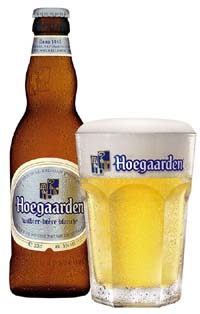Originally published in What’s Brewing September 2002
Origin: Hoegaarden, Brabant, Belgium
ABV: 5%
Buy from: most supermarkets, beer shops

Hoegaarden Wit
Unfiltered ‘white’ beers were once the local speciality of the northeast corner of Brabant. Brewers here used unmalted wheat, giving a very fruity, phenolic and distinctively wheaty flavour, and spiced their beers with coriander and curaçao orange peel, as they had been doing since long before the ubiquity of the hop. Such idiosyncratic beers found it hard to survive in the new world of industrialised brewing and they died a quiet death in the 1950s.
Then in 1966 Pierre Celis, who had helped out at a local white beer brewery as a teenager, opened De Kluis (the cloister) brewery in the once-important brewing village of Hoegaarden. Celis set about recreating the defunct style, with some success, especially among the young. Interbrew became financially involved in 1978 and eventually bought Celis out, using their marketing clout to turn this ancient style into a national and then an international brand.
Hoegaarden is still brewed at De Kluis, using barley malt, unmalted wheat, Saaz and Goldings hops, coriander seeds and dried curaçao peel. Some aficionados complain it has lost its character in Interbrew’s hands. I first tasted it in the early 1990s and though I have no detailed notes from the time, I do know it was so good then that it triggered off my enduring passion for Belgium and its beers. When I taste it today, for better or worse, I can still understand why.
Served cool (and neat – in Belgium lemon is rarely added) in its distinctive chunky tumbler, Hoegaarden is pale cloudy straw-yellow with a rich white head. The aroma is smooth, creamy and spicy, with a whiff of coriander and restrained hops. The palate is soft and wheaty at first, but soon reveals complex herbal and hoppy flavours as it swirls over the tongue, with tangy and perfumed orange fruit. The hops become more rounded in the finish, dominated by a persistent fruity tanginess, and the final impression is creamy but clean and refreshing.
Together coriander and hops can easily turn a beer into a shouting match of flavours if mishandled, as many brewers have found to their cost. Hoegaarden gets it just right: the coriander is distinct but not overpowering, and beautifully integrated with a subtle blend of classic hop flavours that gives the beer a lift in just the right place.
Today every other Belgian brewery offers a wheat beer, and Celis’s revival has made brewers around the world realise there’s more to a good grist than barley malt. Connoisseurs sometimes overlook the original, perhaps because it’s too easy to find and no-one can quite believe a speciality of such quality could flow forth from a megabrewer. Such self-denial is misplaced, since Hoegaarden still well deserves its title as the benchmark of the style.
Try also: Abbaye des Rocs Blanche des Honelles (Belgium), Annoeullin L’Angelus (France), Gulpener Korenwolf (Netherlands), Lefèbvre Student/Blanche des Bruxelles (Belgium), Salopian Puzzle (UK).
Read more at ratebeer.com: http://www.ratebeer.com/beer/hoegaarden/399/





Leave a Reply